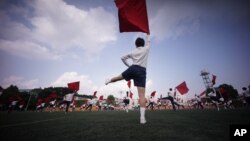Prior to the end of World War II, there was no North or South Korea. There was only one nation, occupied by Japan. When Tokyo surrendered to Allied forces in 1945, the peninsula was split in two at the 38th parallel, and thousands of ethnic Koreans were left in Japan.
In the decades since, many of their descendants have decided to stay and currently number over 600,000.
While there are several ethnic Korean groups registered in Japan, two receive the majority of the attention.
Established in 1946, the Mindan group has ties to South Korea, while the Chongryon has closer ties to North Korea. Roughly 65 percent of ethnic Koreans affiliate themselves with Mindan and 25 percent are members of the latter.
Grant Newsham, a senior research fellow with the Japan Forum for Strategic Studies in Tokyo, said historically, both groups focused on wanting “their members to get along in life [in Japan] comfortably.”
“As the generations pass,” he said, “the younger people of both organizations seem to [have] less of a political angle… less commitment to the motherland [and] the fatherland than there than there used to be.”
Newsham asserts that is a natural progression of events as the descendants spend more time in Japan and become integrated into its society.
Mindan’s role
Mindan’s self-described role is to connect the Japanese Korean diaspora with their homeland and, according to its website, operates under five principles to support South Korea’s domestic and foreign policies.
“Although we live in Japan, we are overseas citizens with Korean nationality. We will endeavor to realize the national policy of freedom and democracy, and peaceful reunification of Korea, as chosen by the home Koreans,” the website says.
In 1977 it established the Peaceful Reunification Promotion Headquarter to “spread the peaceful reunification policy of the Korean government throughout Japan.”
However, when VOA reached out to the Mindan for comment on the inter-Korean engagement embraced by South Korean President Moon Jae-in, the prospects for denuclearization, and a possible visit to Seoul by North Korean leader Kim Jong Un, the group declined to comment.
Mindan further seeks to be a “bridge connecting Korea and Japan... [to] contribute to the globalization with the idea of 'multi-cultural harmony' and 'respect for the human rights'.”
However, Newsham compares Mindan’s present-day role to one more similar to a political action committee or lobbying group with efforts directed to local, Japanese issues rather than ones between states.
He said that as the younger generations continue to live and thrive economically in Japan, the connection to South Korea diminishes, possibly one day resulting in the question of the need for the organization.
The Chongryon and North Korea
The General Association of Korean Residents in Japan, also simply referred to as the Chongryon, is the second largest group is Korean diaspora living in Japan.
The group has maintained close ties with the Democratic People’s Republic of Korea, North Korea’s official name, since the end of World War Two.
Newsham said the Chongryon’s existence benefits the Pyongyang leadership because it “serves as a listening post for North Korea,” although it may have been of greater use to the Kim regime during the past, more so than today.
“I think it's more for North Korea's benefit to have a sympathetic… group in Japan,” he said, since “it's gotten much harder for the North Koreans in Japan to move money” in the past 10 years.
According to the Chongryon website, the organization was formed with the goal of creating “a democratic and patriotic organization representative of [ethnic Koreans living in Japan’s] will and interests.”
The group says it adheres to “national reunification movement” defined by North Korean founder Kim Il Sung.
VOA reached out to the organization, but it declined to be interviewed about the current political situation on the peninsula and with Japan, stating “it was not a good time.”
Current political activity
Both the Mindan and Chongryon continue to work closely with various politicians to advance their individual causes, and on occasion work together, when appropriate.
However, Newsham says that in general, there are better feelings toward Mindan than Chongryon, something he attributes to the democratic principles shared by both Seoul and Tokyo.
The North aligned Chongryon “has always been seen as something sinister and as a “fifth column in Japan,” a term used to describe a group that undermines another, usually in favor of an enemy.
Newsham notes that both North and South Koreans have “their own support base within the political world.”
Rie Nagashima contributed to this report.








